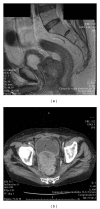Sarcomatoid carcinoma of the prostate: ductal adenocarcinoma and stromal sarcoma-like appearance: a rare association
- PMID: 22606622
- PMCID: PMC3350221
- DOI: 10.1155/2011/702494
Sarcomatoid carcinoma of the prostate: ductal adenocarcinoma and stromal sarcoma-like appearance: a rare association
Abstract
Sarcomatoid carcinoma (SC) of prostate gland is a rare biphasic tumour. In about half of cases, initial diagnosis is acinar adenocarcinoma, followed by nonsurgical therapy, with a subsequent diagnosis of SC. The survival rate is lower. We report a case of an 59-years-old man with unusual histopathologic finding of prostate sarcomatoid carcinoma, showing characteristics of ductal prostatic adenocarcinoma and prostatic stromal sarcoma-like appearance. Ductal adenocarcinoma was characterized by tall columnar cells with abundant amphophilic to eosinophil cytoplasm. Pleomorphic sarcoma was characterized to have overall glandular growth pattern, simulating a malignant phyllodes tumour. Estrogen and progesterone receptors showed nuclear immunostaining in mesenchymal multinucleated giant cells. In conclusion, SC of the prostate is an exceedingly rare tumour. Retrospective analyses render prostate SC as one of the most aggressive prostate malignancies. The prognosis is dismal regardless of other histologic or clinical findings.
Figures



Similar articles
-
Sarcomatoid carcinoma of the prostate: a study of 42 cases.Am J Surg Pathol. 2006 Oct;30(10):1316-21. doi: 10.1097/01.pas.0000209838.92842.bf. Am J Surg Pathol. 2006. PMID: 17001164
-
High-grade prostatic intraepithelial neoplasialike ductal adenocarcinoma of the prostate: a clinicopathologic study of 28 cases.Am J Surg Pathol. 2008 Jul;32(7):1060-7. doi: 10.1097/PAS.0b013e318160edaf. Am J Surg Pathol. 2008. PMID: 18496142
-
Sarcomatoid carcinoma of the prostate: a case report.Int J Clin Exp Pathol. 2010 Feb 5;3(3):319-22. Int J Clin Exp Pathol. 2010. PMID: 20224731 Free PMC article.
-
Histologic classification of prostate cancer.Anal Quant Cytopathol Histpathol. 2015 Feb;37(1):39-47. Anal Quant Cytopathol Histpathol. 2015. PMID: 26072633 Review.
-
Sarcomas and related proliferative lesions of specialized prostatic stroma: a clinicopathologic study of 22 cases.Am J Surg Pathol. 1998 Feb;22(2):148-62. doi: 10.1097/00000478-199802000-00002. Am J Surg Pathol. 1998. PMID: 9500215 Review.
Cited by
-
Ductal adenocarcinoma of the prostate: A systematic review and meta-analysis of incidence, presentation, prognosis, and management.BJUI Compass. 2021 Jan 5;2(1):13-23. doi: 10.1002/bco2.60. eCollection 2021 Jan. BJUI Compass. 2021. PMID: 35474657 Free PMC article. Review.
-
Sarcomatoid prostate carcinoma: a case report.BMC Urol. 2025 Apr 25;25(1):104. doi: 10.1186/s12894-025-01790-y. BMC Urol. 2025. PMID: 40281516 Free PMC article.
References
-
- World Health Organization Classification of Tumours: Pathology and Genetics of Tumours of the Urinary System and Male Genital Organs. IARC Press, Lyon, France, 2004.
-
- Humphrey PA. Variants of Prostatic Carcinoma in Prostate Pathology. Chicago, Ill, USA: ASCP Press; 2003.
-
- Grignon DJ. Unusual subtypes of prostate cancer. Modern Pathology. 2004;17(3):316–327. - PubMed
-
- Mazzucchelli R, Lopez-Beltran A, Cheng L, Scarpelli M, Kirkali Z, Montironi R. Rare and unusual histological variants of prostatic carcinoma: clinical significance. BJU International. 2008;102(10):1369–1374. - PubMed
-
- Shannon RL, Ro JY, Grignon DJ, et al. Sarcomatoid carcinoma of the prostate: a clinicopathologic study of 12 patients. Cancer. 1992;69(11):2676–2682. - PubMed
Publication types
LinkOut - more resources
Full Text Sources

